Aramaic Project
No. 190 to 181 - Interviews and Performances - Video List
Goto Item No. 189 | 188 | 187 | 186 | 185 | 184 | 183 | 182 | 181| Aramaic Project Number | Description | Duration | Date and place of Recording | Video |
| 190 | Crowning of Anju Koovaplackal & Bijo Kattuvallil reclaiming an old tradition Reclaiming an old wedding custom. The Crowning ceremony of Anju Koovaplackal and Bijo Kattuvallil A new trend among young Syro Malabar Catholics to introduce a ritual that is not in the official ritual. This video represents a new trend developing among young Syro Malabar Catholics who wish to reinstate an old custom of crowning the bride and groom as part of the wedding ceremony. This is a Middle Eastern/Jewish custom that the Syriac Christians in Kerala continued or adopted. Some of the Syriac Churches, for example, the Assyrian Church of the East, include the ceremony in their official Ritual with specific prayers. The Syro Malabar Church, however, does not include crowning in the wedding ritual. Yet, some couples want the ceremony and a few priests are willing to do it. Fr. Cyril Thayil, the celebrant in this video, is one such priest (see Fr. Cyril in conversation:). The video also shows yet another development of concluding the church ceremony with the Syriac hymn, "Bar Maryam." This, too, is not part of the official Ritual, although the Knanaya Christians consider it a significant part of the celebration. We are archiving these videos and making them available for researchers who might be interested in history in the making. We thank Abin Koovaplackal (Australia) for sharing this video with us and for granting permission to post it on our channel. The bride in this video is Abin's sister. We wish the newly married couple all the best. See also: Nuptial Qurbana and Crowning ceremony Joseph J. Palackal, CMINew York 13 May 2020. Keywords: Anju Bijo Kattuvallil, Crowning ceremony, Syro Malabar Marriage ceremony, Koovaplackal |
12:02 | 4 November, 2019 St. Sebastian's Church, Udayapuram, |
 |
| 189 | "MAR WALAH" for post-communion meditation. Dallas, Texas
“Mar Walah” (“My Lord and my God ;” John 20:28) is the most succinct profession of faith in Jesus Christ as both God and Man. It was Thomas the Apostle who first used the term, ALAHA (God), to refer to Jesus. The word is more profound than Misiha (Messiah) that St. Peter used in answer to the question, “But who do you say that I am?” (Mark 8:29). Ironically, the most certain assertion of the divinity of Jesus came from the Apostle, who is often called as “Doubting Thomas”. Mar Walah, the simple, three-syllable phrase, maybe the first step toward introducing Syriac literacy among children. And it is an honor and a privilege for Christian children in India to start their Syriac lessons as well as catechetical training with a unique phrase that came from Thomas the Apostle, their father in faith. Additionally, the expression contains an essential lesson in Syriac grammar that highlights the difference between the phonemic (written) and the phonetic (sound) versions of words in the Syriac language. For example, the Syriac word "Mar" is written as "Mar(y)," with a silent yod at the end. This silent yod, however, changes the meaning considerably; the yod adds a first-person, possessive case to Mar, meaning “My” Lord. "Mar Walah" could serve as the first lesson in catechesis, too. Children can experience the foundation of faith in Jesus as both God and Man. Such an experience may lead to the realization that faith is as intimate to them as their breath (“Ruh/Ruha”). The idea of a simple, singable, and celebratory melodic design for Mar Walah happened to me on Sunday, 22 September 2019 in the backyard of the St. Thomas Syro Malabar Catholic Church in Boston. I was a guest of the Parish for that weekend. My mission was to prepare the choir to sing the English version of Qurbana that I co-composed. The vicar asked me to teach Sunday school children as well as the parish choir before the 10.30 am Qurbana. It was a beautiful day with bright sunlight. After breakfast, I took a walk in the backyard of the church. Most of the birds had finished their morning prayer; some were still active in praising their creator. A soft wind caressed the grass on the ground and the leaves on the full-grown trees. Overall, it was a wonderful time of the Fall season. I was planning in my mind how to conduct the music training session. All of a sudden, out of the blue, the phrase “Mar Walah” in this melodic format came to my mind. I could not resist it. I sang it to myself and then to the trees around; the dancing leaves in the soothing wind nodded in appreciation. An hour later, I sang it to the children in the church. The children learned it easily and responded to me enthusiastically. We ended the homily by singing it again. I was pleased with the outcome. The next weekend, I had the opportunity to celebrate the Qurbana for the Sunday School children at the St. Jude Syro Malabar Church in Northern Virginia (see Aramaic Project-158 ). At this time, I tried to add the Malayalam version of Mar Walah. The children and their parents enthusiastically responded. The Malayalam text fitted well into the melodic contours of the Syriac text. Overall, it turned out to be a celebratory experience. On the weekend of Sunday 16 February 2020, I was invited to train the Sunday School choir at St. Alphonsa Syro Malabar Church at Coppell in Dallas, Texas. The choir and the Sunday school children learned Syriac chants to celebrate a bilingual Qurbana in English and Syriac. This gave me a perfect opportunity to introduce Mar Walah to a different community. We decided to use the song as a post-Communion meditation. What we see in the video is a recording of that event. It became clear that Mar Walah is the most appropriate prayer for thanks giving after Holy Communion. In Communion, Jesus grants us the privilege of physical intimacy that is similar to what He granted the Apostle Thomas, during the second appearance (John 20:27-29). I hope and pray that priests take a cue from this video and take this experiment to the next level. Joseph J. Palackal, CMINew York 7 May 2020 Keywords: Mar Walah, Thomas the Apostle, Syro Malabar Church USA, Syriac chant, USA |
3:45 | 16 February 2020. Syro Malabar Church, Coppell, Dallas, Texas. |
 |
| 188 | The joy of singing Syriac chant: Norah Bibin, Noah Bibin & Jonah Bibin Norah Bibin, Noah Bibin, and Jonah Bibin sing the Trisagion , Qandisa alaha in Syriac The three siblings in this video engage themselves in an unusual activity during the period of lockdown due to the Covid-19 pandemic. Surprisingly, the children also seem to be enjoying the activity immensely. While watching the video, I could not take my eyes off the youngest of the three, who seems to be enjoying the most; he is eagerly taking musical and textual cues from his older brother and sister. We are grateful to Dr. Bibin Jose and Dr. Manju Raju, the parents of these children, for capturing the beautiful moments on the video and for permitting us to post it on our channel. This is a precious addition to our ongoing archiving of the status of the Syriac language in the twenty-first century. This video is a welcome addition to several others that show children engaging in Syriac-related activities. For example, in (Aramaic Project-186), we saw two young boys singing the Syriac alphabet. In these and several other instances, the credit goes to the young parents who create a congenial atmosphere at home for Syriac-related conversations. Ironically, if this trend continues, and if children maintain their interest and learn more songs during their teenage and adult years, there will be a more informed laity than clergy in the Syro Malabar Church in matters related to liturgy. That will be a reversal of the history of the Syro Malabar Church in the second half of the twentieth century. The informed laity may enforce the reinstatement of at least a few Syriac chants into the Syro Malabar liturgy. Many of us may not be alive to see those days, but this video, as well as similar videos on this channel, will be a sound testimony to that sacred historical trajectory. Joseph J. Palackal, CMINew York 5 May 2020 Keywords: Norah Bibin, Noah Bibin, Jonah Bibin, Trisagion, Qandisa alaha, Syriac chants. |
2:59 | 24 April, 2020 Residence of Dr. Bibin Jose |
 |
| 187 | The oldest Christian chant in India, Bar Maryam?/ Vatican Radio Dr. Joseph J. Palackal, CMI answers a question from Fr. William Nellkkal, the director of the Malayalam section of the Vatican Radio, on the oldest Christian chant in India. What follows is an interesting and intellectually stimulating conversation on the research possibilities on Christian music of India. This was the second interview on Vatican Radio. Broadcast on January 2016 http://thecmsindia.org/bar-maryam-son... Note: During a friendly and free-spirited interview for the Malayalam section of the Vatican Radio, Fr. William Nellikkal came out with a difficult question on the earliest known Christian chant in India. My answer may be controversial. I would like informed viewers to challenge my argument and come up with their ideas. The answer, however, shows that Christian music of India in general, and Syriac chants in India, in particular, can be topics for deep doctoral researches in multiple disciplines at the musical, cultural, linguistic, theology, religion, and Anthropology departments of universities. A correction for 2:54. The phrase, "Son of Mary," does appear in Mk 6:3. My apologies. More information on this chant is available on our Encyclopedia of Syriac Chants. http://thecmsindia.org/bar-maryam-son... Joseph J. Palackal, CMINew York 23 April 2020 Keywords: William Nellikkal,. Joseph J. Palackal, Vatican Radio, Syriac chants, Aramaic Christianity in India, Bar Maryam |
10:24 | 22 & 23 January, 2016 Vatican Radio |
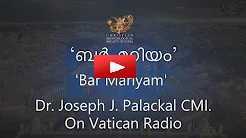 |
| 186 | Two young boys sing the Syriac alphabet Nebil Aneesh and Joel Aneesh, sing the Syriac alphabet at home, Melodic design by Thoma Mathai Thalikasthanam, Nasrani Foundation, Title music: Bar Maryam on piano by Catherine Felix Note: This video is a clear indication that the conversation on the Syriac heritage of the Syro Malabar Church is overflowing from the academic circles to children and families. We posted several videos of children singing or playing Syriac chants. In this video, we see the two young boys going a step further by trying to learn the Syriac alphabet. The simple, singable melody that Thalikasthanam Thoma Mathai designed became a resource for the boys. The Nasrani Foundation posted the melody on its Youtube channel. Nasrani Foundation did excellent service by drawing attention to the rich Syriac heritage of India and generating an open-minded discussion on it. What we see in this video is the fruit of that labor of love. We also want to acknowledge the young parents of these and other children who provide a congenial space for conversation in the intimacy of their homes. If more parents decide to do this, the sound and the sentiments of the Syriac language may migrate into the minds of the younger generation. We are grateful to Denny Sales Karamkunnel, a teenager from Palakkad, for sharing this video and encouraging the parents of these children to keep the conversation alive. May we ask everyone to send their blessings to Nebil and Joel and on the people who work on the Aramaic Project. Please pray that we find enough resources to continue the Project. Joseph J. Palackal, CMI Keywords: Syriac alphabet, Nebil Aneesh, Joel Aneesh, Jarly Mathew, Thoma Mathai Thalikashanam, Nasrani Foundation |
2:54 | 12 April,2020
|
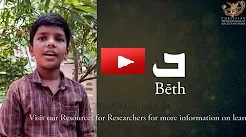 |
| 185 | Catherine Felix plays the Syriac chant "Bar Maryam" (Son of Mary) on piano. Catherine Felix of Northern Virginia, USA, plays the melody of Bar Maryam on piano. Music notation by S. Sebastian. Text and staff notation, see: thecmsindia.org/bar-maryam-son-of-mary The centuries-old Syriac chant, Bar Maryam (Son of Mary) has captured the imagination of generations of St. Thomas Christians in Kerala and abroad. Besides the Christological and Mariological significance of this chant, the simple but haunting melody plays in the mind like in a loop after one hearing. S. Sebastian (Atlanta, USA) notated the melody for the use of the choir at the Syro Malabar Convention in Houston (1 August 2019). Catherine, daughter of Felix Simon, the co-founder of the Aramaic Project, experimented with the melody on her piano at home. This is the first time we hear this melody with the sonority of a piano. Catherine makes two iterations of the melody with two different ways of chordal accompaniment. The second iteration is her own improvisation on the harmony. Earlier in 2014, we saw Catherine at her First Communion, leading the Lord's Prayer in Aramaic (see Aramaic Project 21 ). Catherine kept up her interest during the ensuing years. For more information on the text, melody, staff notation, and theological significance of this chant, see our Encyclopedia of Syriac chants: thecmsindia.org/bar-maryam-son-of-mary Joseph J. Palackal, CMI Keywords: Catherine Felix , S. Sebastian , Bar Maryam , Syriac chants , Aramaic chants in the USA | 2:43 | Residence of Felix Northern Virginia, USA 2 April, 2020 |
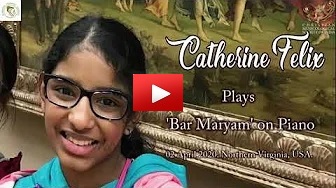 |
| 184 | CMI fathers in North America learn, "Bar Maryam" (Son of Mary). The CMI fathers in North America learn the famous Syriac chant, Bar Maryam (Son of Mary), to sing at the end of night prayers. Immaculate Conception Seminary, Huntington, New York. 13 February 2020. Traditionally, the CMI communities end their daily night prayers (Lelya) with a Marian hymn from outside the books of the Hours. Here we see the CMI fathers in America and Canada, who spent a week for the Constitution retreat, learning the Syriac chant Bar Maryam to sing at the end of Lelya on one of the nights. Bar Maryam is a Christological hymn with a repeated reminder of the fact that the Son of God is also the son of Maryam (Bar Maryam). See more information on this chant in our Encyclopedia of Syriac Chants bar-maryam-son-of-mary Keywords: Bar Maryam , Bar Mariyam, CMI USA, Syriac chants, America Joseph J. Palackal, CMI | 2:21 | Immaculate Conception Seminary, Huntington, New York 13 Feb, 2020 |
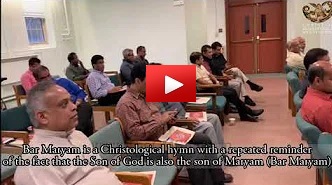 |
| 183 | FATHER VS SON: Dr. Thomas Kalam vs Philip Kalathil. contrasting views. Contrasting views on the vernacularization of the Syro Malabar liturgy (1962). Dr. Thomas Kalam recalls a conversation between his father, Philip Kalathil, who made a special visit to the CMI Novitiate House in Chethippuzha to speak to his son, a CMI novice at that time. Philip's request was to have his son promise that he would not celebrate the Syro Malabar Qurbana in the vernacular. Note: Dr. Thomas Kalam, CMI, retired professor of Moral Theology at Dharmaram Vidya Kshethram and former Director of St. John’s Medical College in Bengaluru, was kind enough to share his take on the public reception of the vernacularization of the Syro Malabar liturgy. Young Thomas and his classmates, who knew to read and write in Syriac, were thrilled about the possibility of celebrating Qurbana in Malayalam. The response of the older generation, however, was different. The older generation that did not know the nuances of the Syriac language, had developed strong sentiments and emotional affinity to the Syriac language. The most important reason for that emotional attachment was their pride in possessing the sound of the mother tongue of Jesus and the apostles. Although they had only a vague idea about what was going on, they knew that the priest was uttering the exact words that Jesus spoke at the last Last Supper. They wanted to hold on to that sense of mystery and sacrality. Dr. Kalam’s Dad was so upset about the possibility of his son celebrating Qurbana (several years later) in the vernacular that he made a trip to the Novitiate House, got special permission from the Novice Master to speak to his young son and make him promise that he would not celebrate Qurbana in Malayalam. Dr. Kalam, who is a fearless, independent thinker, also spoke about the current status of the liturgical discourses in the Syro Malabar Church that more attention to rubrics and less attention to the unique theology and spirituality that is part of the Syro Malabar liturgy. We are grateful to Dr. Kalam for his candid conversation that may be helpful to future researchers on the transition era in the history of the Syro Malabar liturgy. Joseph J. Palackal, CMI Keywords: Thomas Kalam, Philip Kalathil, Syro Malabar liturgy, Syro Malabar Church ,views on vernacularization, Placid Podipara. | 13:52 | Compus of the Immaculate Conception Seminary, Huntington, New York 12 Feb, 2020 |
 |
| 182 | PAILY VATHAPPALLY ON THE LIFE OF A CHURCH MUSICIAN IN THE SYRIAC ERA
Paily Vathappally, retired church musician at St. Mary's Forane Church at Pallippuram, Cherthala, in a candid conversation on the life of church musicians in the Syriac era. Interviewed at his home on a hot humid and rainy day in July. We are delighted to have captured a few moments from the life of a dedicated church musician, who started his service at about the age of ten. Mr. Paily Vathappillil (aka "Kunjettan") served the St. Mary's Forane Church (my native parish) at Pallippuram for over half a century. Paily came from a family of church musicians. His father, who was the choir leader at the same church for many years, initiated Paily at the tender age of ten. As years went by, Paily learned to accompany himself on the violin as well as harmonium. Paily was blessed with a powerful baritone voice that could reach a large audience without the aid of amplification. Such a voice culture, which used to be the characteristic of bel canto opera in Italy, happened to be the trademark of singers/actors in the foot-stamping dance drama (chavittu natakam) in Kerala. Such a voice culture is not in vogue anymore among both singers of sacred songs as well as secular songs. The four tracks in the CD, “Qambel Maran: Syriac Chants from South India,” see more about it below) that was recorded in 2000, is a testimony to Paily’s powerful voice. In this recording, which took place at his home on a hot, humid, rainy day, however, Paily sings in a subdued voice. A few years before the recording, Paily had become sick and had retired from singing in the church. Paily's generation saw their music ministry more like a mission than as a means of livelihood. On the one hand, the idea of a living wage had not dawned on the church authorities, yet. On the other hand, such singers as Paily considered an honor to serve the liturgy in their parish and sought different ways to support their families. Paily never complained; instead, he served with a smile. There was an air of nobility in his demeanor. Paily’s grandson, Paul Joy, sat quietly and seemingly disinterested during the recording session. When it came to singing his favorite Marian hymn, B’eda dyawman, Pual Joy came in front of the camera. It is a blessing to have his rendering of the hymn in the Aramaic Project archive. Toward the end of the interview, Paily recalled the older melody of B’eda dyawman and sang and played it on the violin. This is the melody that the sacristan of the St. Mary’s Forane Church taught me when I was about nine years of age. I made my singing debut with this song. Later, I sang it for the CD, Qambel Maran (see note on track 29, in “Qambel Maran: Syriac Chants from South India,” PAN Records, Netherlands, 2002). Listening to Paily was for me an emotional journey back in time. In 2000, I recorded four Syriac chants in Paily's voice for the CD, Qambel Maran: Syriac chants from South India (see notes on tracks 19, 27-28). At the end of the video recording, we said goodbye with the hope to meet and again and document more songs from his memory. Unfortunately, God called Paily for his eternal reward before my next trip to Kerala. May he continue to sing with angels in heaven in the Syriac language, the language of Jesus, Mary, Joseph, the Apostles as well as the angels. Joseph J. Palackal, CMINew York Keywords: Vathappally Pallippuram, St. Mary's Forane church, Syriac era of the Syro Malabar Church, Paul Joy Vathappally |
16:45 | Residence of Paily Vathappally, Pallipuram, Cherthala. 25 July, 2013 |
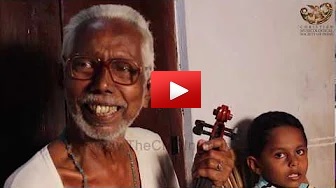 |
| 181 |
Mar Joseph Powathil: Burning with zeal for the Syro Malabar Church It was indeed an honor to have a conversation with retired Archbishop Mar Joseph Powathil, a valiant son of the Syro Malabar Church. Mar Powathil spent the formative years in a multi-ritual context in Pune, where there was not much opportunity to master the nuances of the Syriac language. The Seminarians learned enough to celebrate Qurbana and the Hours. Mar Powathil’s interest in the Syriac heritage evolved out of a need to understate and explain his identity in a multi-ritual setting. A study of the historical trajectories that led to the Synod of Diamper became a turning point in Mar Powathil’s life. From then onwards, it was a life-long mission to understand and uphold the unique identity of the Syro Malabar Church among all other Christian churches in India. In the process, Mar Powathil emerged as a spokesperson for not only the Syro Malabar Church but also for the St. Thomas Christians and South Indian Christianity itself. We are grateful to Mar Powathil for allowing this recorded conversation and pray that God grants him health to serve the church for many more years. Joseph J. Palackal, CMI New York 31 March 2020 |
21:14 | ArchBishop's House, Changanaserry 01 April, 2014 |
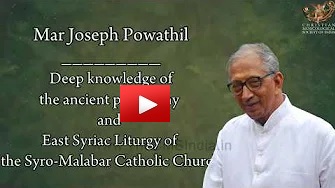 |



